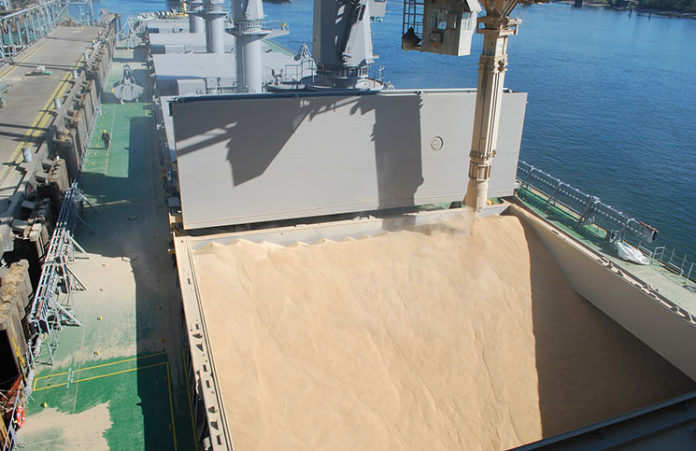
Vancouver isn’t a city that anybody would call an agricultural hub for soybeans, but the Port of Vancouver remains a major waypoint for their shipment overseas.
Last year, about 2 million metric tons of soybeans flowed through the port, mostly to China. But this year, with the Trump Administration’s tariff war against China, and China’s July retaliation with a 25 percent import tax, the port had only shipped 67 metric tons of soybeans by the end of September.
Meanwhile, soybean farmers in the Midwest are stacking up product wherever they can – in storage areas up and down the rail line to the port – hoping that either the trade war will end soon or that new international customers can be found.
“The soybeans are usually destined for China,” said Alex Strogen, chief commercial officer at the port. “It’s the single largest market for U.S. soybeans. It goes into food stock, livestock, pig feed. They don’t just eat it.”
Grains make up most of the produce that runs through the Port of Vancouver. Wheat, corn and soybeans are the top three. The port moved 5.3 million metric tons of grains in 2017, a large portion of its 7.1 million metric ton shipping total for the year. Of that, wheat made up about 2 million metric tons, with corn and soy shipments at a slightly lower level.
“It’s a huge cargo for us – wheat, corn and soy,” said Abbi Russell, a spokeswoman for the port. “Wheat has always been big for us, but corn and soy are catching up.”
Soybeans held hostage by the trade war can be stored for about a year, but not much longer than that, Strogen said.
“A lot of it is sitting up the supply chain,” Strogen said. “If you go to the Midwest you see silos, holding facilities near rail and trucking routes. They’re also being stored in polyethylene bags on farmer’s land. I saw one group that was storing grain in a cave.”
There has been some rumblings and negotiations between the Trump Administration and China that the trade war could end soon, but so far, it’s hard to guess what will happen, he added.
“We’ve got a window of opportunity,” Strogen said. “There is some anticipation that the Trump Administration will come to an agreement soon in terms of trade.”
In the meantime, though, farmers and shippers are living in fear of the Brazilian soybean harvest, which is likely to come early this year.
“The challenge for U.S. farmers now is that our big competitor for soy is Brazil, and Brazilian stocks will hit the market earlier than usual this year,” Strogen said. “It usually comes in March, but it’s looking like January this year.”
China’s demand for soybeans has grown consistently as the country has industrialized, and the demand for meat has increased, Russell said.
“The middle class in Asia and China has grown, and so has the demand for meat,” Russell said. “That has increased the demand for soybeans as livestock feed.”
China has already shifted to buying soybeans from Brazil, and with the 25 percent tariffs, U.S. soybeans cost about the same for China now as Brazilian soybeans. But China isn’t buying U.S. soybeans even though the prices are now similar to Brazil, because of the uncertainty around the trade war, Strogen said.
Instead, Brazil is shipping so many soybeans to China that it’s actually buying some from the U.S. for domestic use.
“Some of our soybeans are actually going to Brazil for their own use, because they’re selling everything they’ve got,” Strogen said.
Beyond soybeans, there have been other major agricultural impacts from the trade war on the state of Washington. Sale of apple and cherry harvests to China have dropped through the floor.
Most of the state’s agricultural products are shipped through the Seattle area, while Vancouver is focused mostly on grains.
A recent study compiled by the Trade Partnership using data from the Census Bureau found that Washington farmers have seen a drop in demand for exports. Produce tariffs cost Washington farmers $103 million more in 2018 than in 2017.
According to the data, released by Tariffs Hurt the Heartland, in 2018 Washington cherry growers lost $80 million in sales and Washington apple growers lost $130 million in sales due to the trade war.
Washington consumers also paid about $100 million more for imported goods since the tariff war began, said Melanie Lehnhardt of Tariffs Hurt the Heartland.
If the trade war continues much longer, it could have a major impact on jobs in Washington, said Lori Otto Punke, president of the Washington Council on International Trade, in a release.
“Forty percent of all jobs in Washington state are trade-related,” Otto Punke said. “The trade war inflicts disproportionate harm on Washington’s workers, businesses, and communities. The current tariff-first approach to trade policy has done little more than invite retribution and hinder needed cooperation. This is not the way to do business for Washington state.”
If an agreement is reached with China, U.S.-grown soybeans could move very quickly through the Port of Vancouver. And the port says its more than ready to take them.
The port also made a concentrated effort to diversify what it ships starting about five years ago, and that has put it in good shape despite the tariff issues, Strogen said.
“Our rail capacity here is really second to none,” Strogen said. “One thing the port’s been really passionate about is diversifying what we do. We do not put all of our eggs in one basket. We concentrate on everything from finished goods to pulp to product cargos. We’ve been able to weather the storm because of that diversification.”





